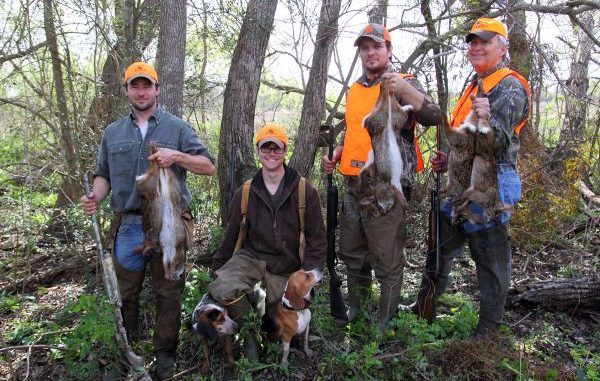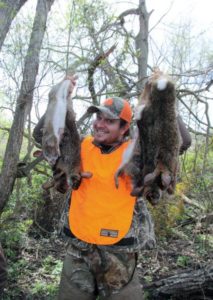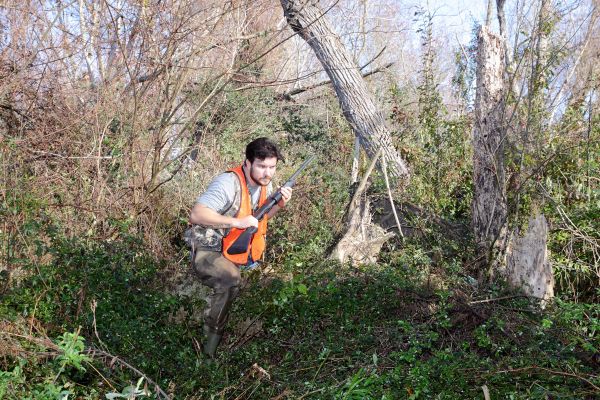
For hunters used to working dogs for a cottontail or two, a swamp rabbit shoot can be an eye-opening experience. Here’s what one out-of-stater learned on his first swamper hunt.
Brothers Matthew and Porter Watson McCollister are dog men. I got that the first time I met Matthew, when he loaned me a book to read written by J. Frank Dobbie titled The Legend of Ben Lilly.
Only, the baying I heard getting more and more faint by the second was Porter’s dogs chasing a bobcat down the canal bank in the marsh where we were hunting swamp rabbits. I guess the two beagles read the book, too, because they were chasing the cat like it was one of Lilly’s cougars.
All kidding aside, it wasn’t funny at the time. Porter’s beagles weren’t one of Lilly’s southern Catahoulas or coonhounds. What would happen if the two dogs treed the cat?
Porter McCollister had traveled down from Nashville, Tenn., to visit his brother Matt, who works for the U.S. Fish & Wildlife Service as a refuge specialist on Bayou Teche National Wildlife Refuge near Franklin. Part of the trip would be to do some swamp rabbit hunting with his brother and then help put on a bucherie for their parents, who were traveling to join them later in the week.
Piling in my boat, we struck out in a hurry for the back end of the canal to try and head the dogs off. By the time we got there all turned out well, as both dogs had had enough of the cat chase.
And Porter’s electronic collars the dog sported for neckties had them in check once again.
We decided to rework the long canal bank back toward where we started, since the dogs paid little attention to rabbit scent while giving chase to the wild bob-tailed feline.
And in minutes the canines were making sport with another big swamp rabbit — this time in the right direction without the distractions.
 Porter is a commercial real estate salesman in Nashville when he’s not in the woods chasing rabbits with his dogs. For the Tennessean, the opportunity to hunt swamp rabbits was a departure from the upland woodlot cottontails he was accustomed to.
Porter is a commercial real estate salesman in Nashville when he’s not in the woods chasing rabbits with his dogs. For the Tennessean, the opportunity to hunt swamp rabbits was a departure from the upland woodlot cottontails he was accustomed to.
“It’s a different animal,” he said. “Down here it’s all swamp rabbits, and we don’t have swamp rabbits back home. They’re all cottontails.
“The animal itself is twice as large. It’s faster and runs farther, but it has got more scent so the tracking is usually pretty successful.”
That’s not where the departure in experience ends.
“Marsh hunts are also completely different than anything I’m used to,” Porter said. “It’s a little bit more chaotic because of the high density of animals. Back home, we’re so used to jumping a rabbit, running a race and, when it comes back, harvesting it.
“Here it’s more like flushing them; you could be shooting several rabbits while the dogs are packed up chasing a different rabbit.”
One of the other factors to which cottontail hunters must get accustomed to when hunting swamp rabbits is the terrain. The name “swamp” should be a dead give away.
And the souped-up Cajun version of cottontails even has a different scientific name sylvilagus aquaticus, that points to the terrain difference. It’s that “aquaticus” part that got McCollister’s attention early on.
“The vegetation is very different,” he said. “The first day out in the marsh, 10 minutes into the race, I fell up to my chest punching a hole through the flotant. I didn’t realize that it would do that.
“I stepped on a cottonmouth that was out and didn’t realize they were out. And nutria was there — so we ran into animals I wasn’t used too. Back home what I have to worry about is coyotes and finding land to hunt.”
Cutting my hunting teeth on cottontails in Michigan, I can attest to McCollister’s assessment of sheer numbers of rabits available in South Louisiana. A good day in the farm field woodlots of southern Michigan would consist of a couple cottontails in the hunting vest, but it’s nothing for a group of swamp rabbit hunters with dogs to harvest in excess of 40 or 50 swampers in one morning hunt.
An all-time best for a three-man hunt without dogs that a friend, my son and I made one morning along the coast totaled 22 rabbits while walking. We could have picked up the other two for a three-man limit had our bodies not been worn out from busting briars.
And that was on one side of one canal bank no more than 300 to 400 yards in length.
Nonetheless, rabbit hunting has a long-standing tradition in Louisiana. And along the coastal marsh, right after duck season, is the time of year it’s done.
Take any weekend in late January through February, and you’ll see plumes of smoke rising skyward where the marsh is burning somewhere.
In years gone by, the old marsh men would burn the marsh to trap muskrats. Tall patches of cane roseau would pop, crackle and sizzle as the flame lapped over acres upon acres, leaving the terrain sooty black and flat with nothing but the rat hills showing. During cold nights rats would become more active, according to lore, and the next morning a frost would greet the trapper running his trap line.
Today the rats are gone, but the practice of burning the marsh still exists — and is still is allowed by some land companies along the coast. But, in these cases it’s more to condition the ground to hunt rabbits, making it easier for dogs and hunters.
Where burning is not allowed, success means fighting the understory, and the chances of harvesting a limit of rabbits diminishes when attempting to walk up rabbits.
It comes down to your and the dog’s ability to jump them out of protective cover.
One of the things that I’ve taught three sons and numerous friends is to slow down and don’t be in a hurry when coming to a patch of briars that you know holds a rabbit or two. It’s not about covering lots of ground as much as it is covering what you’re hunting more thoroughly; the trick is to get that rabbit to move out of cover and expose itself where a shot can be made.
 The best method in hunting rabbits if you’re dog-less is to zigzag, stop often, bay like a beagle or talk loud, and start over if nothing comes out of the patch.
The best method in hunting rabbits if you’re dog-less is to zigzag, stop often, bay like a beagle or talk loud, and start over if nothing comes out of the patch.
All of these techniques assume there is rabbit sign present. If not, all bets are off and you’re just wasting time.
The ages of Matthew McCollister’s dogs wer 3 years and 11 months old — relatively young. What’s more, the dogs were a work in progress for the Tennessean.
The exposure to the high density of swamp rabbits was not necessarily bad for the pups in training, but the pair of animals lacked the discipline Porter McCollister was accustomed to.
“In Tennessee I spend a lot less time shooting and a lot more time on technique, making sure of things, because (the dogs) are young and still learning,” Porter said. “Here, we’re just kind of playing and shooting some rabbits.
“The first day we hunted with eight other dogs. My dogs packed well, and they bayed really well. Ten guys with eight dogs killed 75 rabbits. So after this, I’ll slow it down and work with them.”
Being a dog man who enjoys small-game hunting, Porter said it’s getting harder and harder to find places to run dogs back in his home state of Tennessee. Also, being in his 30s the hunter feels there is a generational gap that persists where hunting small game is concerned.
“A lot of guys who hunt small game and own rabbit or squirrel dogs are significantly older than I am,” he said. “It has become apparent that there is a generational gap. To me it’s very reflective of the times were in. For example, if you’re my age, we’re all about the convenience and speed.
“We didn’t grow up sitting still, pickling, sewing and fertilizing. That was something our grandparents did. And it’s interesting to me how we lost the focus on small game.”
All of the hunters in our party had an opportunity to shoot swamp rabbits along the coastal canal bank. And, although our quarry wasn’t the cougars and bears Lilly chased with his Catahoulas, it was still fun being dogged out by swampers.
